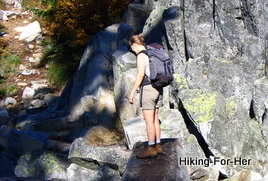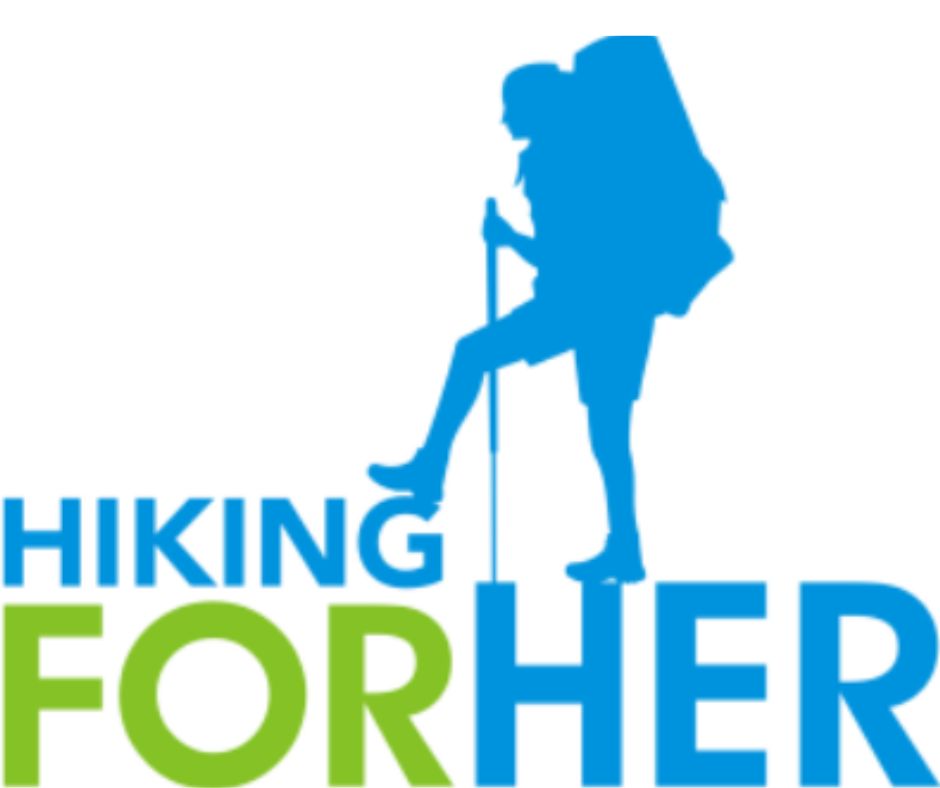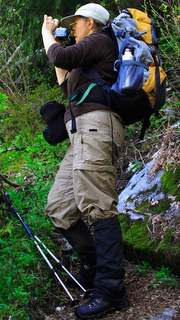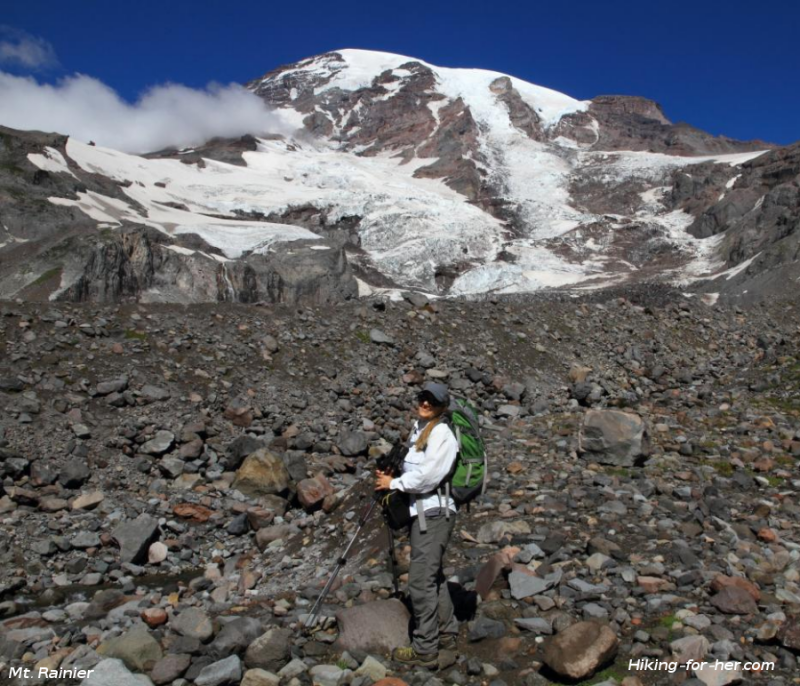Enjoy Happy Trails, the free monthly newsletter from Hiking For Her
Receive a free resource: "Hiking Layering System Explained"
Shoulder Injury Prevention
For Hikers:
Best Tips
By Diane Spicer
Shoulder injury prevention for hikers: sounds wacky?
Don't you hike on your feet, and shouldn't foot or leg injuries be uppermost in your mind?
Ah! You've never had a shoulder injury, have you?
Otherwise, you'd know how a sore shoulder severely impedes your ability to hike any distance at all.
And wearing, and hoisting, a pack on a sore shoulder is NOT fun.
Shoulder injury prevention
starts with hard tissues:
bones
Before we launch into shoulder injury prevention, let's look at how your shoulder is put together.
First, the bones.
Your shoulder (pectoral girdle, where "gird" refers to "strength") has several bones cooperating to make a freely movable joint.
- Have you noticed how much mobility you have in your shoulder area, compared with your elbow or knee?
But all of that mobility comes with a price: stability.
You'll soon see how range of motion requires a shallow socket for bones, and asks a lot of the muscles trying to stabilize the joint.
Your clavicle is a curved bone joining your breastbone (sternum) to the shoulder area. It sits somewhat precariously on a bony prominence on the shoulder blade (scapula).
I know, it sounds weird, doesn't it? Your chest and your back are joined by bony associations.
But how does your arm get into the picture?
The shoulder blade also has a shallow bowl to receive the upper end of your arm bone (humerus).So when you put the whole thing together, you have an arm that swings freely from the trunk and upper chest.
Why are soft tissues
in the shoulder
important?
Now obviously the bones don't just cling to each other like Velcro. You have ligaments holding bone to bone, and tendons holding muscles to bone.
And there's connective tissue between the bones, to provide a slippery frictionless surface for motion in the joints to happen without generating heat.
Are you getting the shoulder picture? There are plenty of spots to create shoulder injuries while hiking!
- Think about hoisting that pack onto your back - which is your dominant hand/arm? (More on hoisting later.)
Muscles provide motion, and strength for lifting. There are lots of muscles in the shoulder area, coming from the chest, back, and neck area.
Some of the bigger ones are obvious in people who lift weights: pectoralis major, deltoid, latissimuss... but there are others hidden beneath these big muscles that can complain if they aren't treated right.
Impingement syndrome is the name given to the inflammation and pain from tendons that are pinched repetitively due to shoulder motions (think about spiking a volleyball, or the overused shoulders of a baseball player).
- Hikers can get into trouble with impingement from backpack straps cutting into the shoulder area for hours at a time.
For more information on possible shoulder injuries a hiker could face, read this American Academy of Orthopaedic Surgeons article.
 Best tip for shoulder injury prevention? Adjust your pack & keep at it until it's comfy.
Best tip for shoulder injury prevention? Adjust your pack & keep at it until it's comfy.
Shoulder injury prevention tips
for the trail
& post-hike
A properly packed and well fitted day pack goes a long way toward shoulder injury prevention for hikers.
- Put the heaviest things at the bottom, and avoid top heavy loads that are a pain to hoist up and carry.
- More detailed tips for how to pack a backpacking pack are right here for you.
Another trick to preventing shoulder strains is to pay attention when you are putting on, or removing, your pack.
- Grasp the pack with both hands, bend your knees, and swing the pack to your back, allowing your strong trunk muscles to help you.
- Don't dangle the pack out in space, asking your spine and arm to do extra work.
And speaking of work, work on your upper body strength by weight training or swimming. You will be able to lift your pack in a smooth fluid motion, and will find putting it on much easier.
After a hike,
don't ignore your shoulders
Be really nice to your shoulders after a long hike.
They helped bear the load of your pack, they allowed you to use hiking poles/sticks and accepted the long hours of swinging your arms, and they provided a nice landing pad for mosquitoes (!).
Some ways to be nice:
- Do a little self-massage when you get back to
the trail head.
- At the very least, scrunch up your shoulders toward your ears and allow those overstretched muscle fibers to relax a little. Ah! Feels good, doesn't it?
Shoulder headache link?
If you're having headaches, it might be smart to work on your shoulders.
Maybe the muscles holding your head on your shoulders are tight, creating tension which shows up in your head as pain.
(Or it could be a dehydration headache.)
And another thing to think about: maybe you need to lighten your load.
Shoulder injury prevention for hikers really needs to start at home, as you go through your pack and make sure you need every item you plan to carry with you.
- If in doubt, leave it out on a day hike.
- Or keep a log of what NEVER gets used, and don't lug it along on a backpacking trip.
More shoulder injury
prevention tips
Next, pack your pack properly: heavy things on the bottom.
At the trail head, do a few shoulder rolls before putting on your pack properly.
Remove your pack whenever possible to give your shoulders a chance to
"breathe" as perspiration evaporates and blood flow normalizes.
And trade shoulder rubs with your hiking buddies after the hike!
Backpack straps digging into your shoulders?
- Try every strap adjustment you can.
- Or if all else fails, create additional padding with old socks duct taped to the straps.
Soothing relief
After a hike, soak in a tub of warm Epsom salts. Your muscles will feel fatigue and soreness drain away with the bath water.
These are easy and relaxing ways to reduce the risk of chronic inflammation!
Shoulder injury prevention strategies at home
One more potential arena for shoulder injury prevention tips: your preferred sleeping position.
- Do you always fall asleep in the same position?
- Would it by any chance be on the side your shoulder happens to be sore?
Investigate different positions, try different pillows (is yours too high or too flat?), and watch how you wake up in the morning: where is your sore shoulder in relation to your trunk?
Changing sleep position habits is a chore, but it might be useful to experiment with this idea in the interest of bidding your sore shoulder good-bye.
One more "one more thing"
Question for you:
On which side do you routinely carry your purse, shoulder bag or heavy grocery bag?
I ask from personal experience here.
I had a chronically sore left shoulder until I realized that my heavy purse was always slung over that shoulder.
- I dumped half of my stuff out,
- switched shoulders, and
- eventually the pain went away.
Convinced I was on the right track toward shoulder injury prevention, I bought a smaller purse with a strap that goes across my chest, and my shoulder feels great again.
So pay attention to your body throughout a normal day at home or in the workplace:- When are you asking your
shoulder to bear weight or work hard?
- You may have your own solution to shoulder pain!
Shoulder injury prevention conclusions
If you already have a sore shoulder, play detective until you can pinpoint - and eliminate - the cause.
Don't want to head into sore shoulder territory?
I'm with you on that one!
Use these Hiking For Her tips to keep your shoulders mobile and pain free on every hike.
- Lots more hiking self care tips here!
Home page > Best Hiking Tips >
Shoulder Injury Best Prevention Tips





